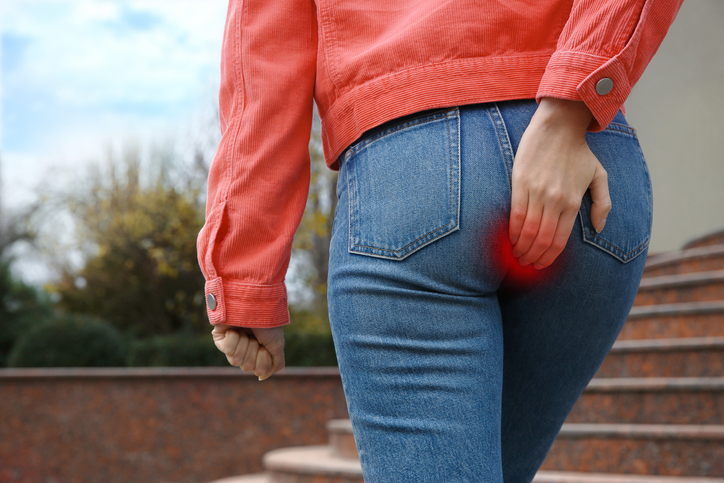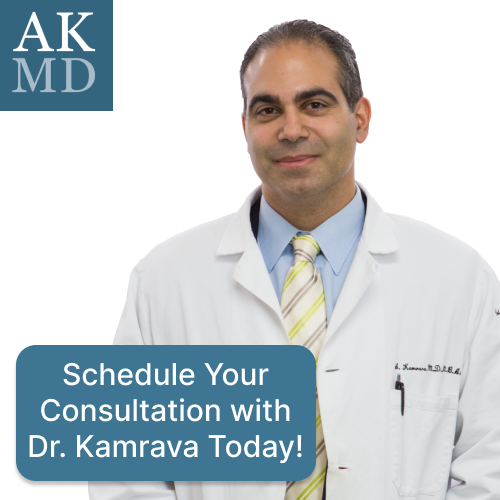Hemorrhoids are a common and often unpleasant condition that affects millions of people around the world. You may be wondering, “how do you get rid of hemorrhoids?”
In this article, we will look at the best way to get rid of hemorrhoids, including laser treatment for hemorrhoids.

Section 1: How Do You Get Rid of Hemorrhoids?
Hemorrhoids can cause discomfort and pain, but there are several effective treatments available to alleviate symptoms and eliminate them. Here are some strategies to consider:
- Changes in Lifestyle and Diet: Making changes to your lifestyle and diet can help prevent and relieve hemorrhoid symptoms. Take a look at the following:
- Increase fiber intake: A high-fiber diet bulks and softens the stool, making it easier to pass without straining. Incorporate fruits, vegetables, whole grains, legumes, and nuts into your diet. Aim for 25-30 grams of fiber per day.
- Stay hydrated: Drinking enough water and fluids throughout the day helps to prevent constipation, which can aggravate hemorrhoids. Aim for at least 8 glasses of water (64 ounces) per day.
- Exercise on a regular basis stimulates bowel movements and promotes healthy digestion. Most days of the week, aim for at least 30 minutes of moderate exercise, such as brisk walking or swimming.
- Avoid prolonged sitting: Prolonged sitting can increase pressure on the rectal area and aggravate hemorrhoid symptoms. Take regular breaks from your sedentary job to stand, stretch, or walk around.
Over-the-Counter (OTC) Medications: OTC medications can provide temporary relief from hemorrhoid symptoms. These are some examples:
- Topical creams and ointments contain ingredients such as hydrocortisone, witch hazel, or lidocaine, which help to alleviate pain, itching, and inflammation. Follow the product’s instructions and apply them directly to the affected area.
- Pre-moistened wipes with witch hazel or aloe vera can provide gentle cleansing and soothing relief.
- Nonprescription pain relievers such as acetaminophen or ibuprofen can help relieve the discomfort associated with hemorrhoids. If you have any underlying conditions or concerns, consult a healthcare professional before taking this medication.
Sitz baths: Soaking the affected area in warm water can help reduce inflammation and provide short-term relief from hemorrhoid symptoms. Take the following steps:
- Fill a bathtub or shallow basin halfway with warm (not hot) water to cover the hips and buttocks when seated.
- Sit for 10 to 15 minutes in warm water several times a day.
- After that, gently pat the area dry or use a hairdryer on a low setting to ensure it is completely dry.
Proper bathroom habits can help prevent further irritation and promote healing:
- Avoid squeezing your bowel movements by taking your time, relaxing, and letting the stool pass naturally. Straining can increase rectal pressure and aggravate hemorrhoid symptoms.
- Use moistened wipes or gentle toilet paper: Avoid rough or scented toilet paper, which can aggravate the area even more. Gentler cleansing can be accomplished with moistened wipes or a bidet.
- Sitting on the toilet for long periods of time can contribute to the development of hemorrhoids. Limit your time on the toilet and avoid using electronic devices or reading while there.
- Consider a stool or footrest: While sitting on the toilet, elevating your feet on a stool or using a footrest can help promote a more natural position for easier bowel movements.
Section 2: Laser Treatment for Hemorrhoids
Laser treatment, also known as laser coagulation or laser hemorrhoidectomy, is a cutting-edge, minimally invasive option for hemorrhoid treatment. A focused beam of light is used in this procedure to shrink and remove hemorrhoidal tissue. Let’s get into the specifics:
How Does Laser Therapy Work?
The use of a specialized medical laser that emits a precise and intense beam of light is used in laser treatment for hemorrhoids. The hemorrhoidal tissue shrinks and coagulates as a result of the laser energy being directed at it.
- Photocoagulation is a laser technique used to treat smaller internal hemorrhoids. The heat from the laser seals the blood vessels that supply the hemorrhoids, causing them to shrink and eventually wither.
- Hemorrhoidectomy: Laser hemorrhoidectomy may be performed in more severe cases or on larger hemorrhoids. The laser is used to cut and remove the hemorrhoidal tissue.
Benefits of Laser Treatment: Compared to traditional surgical methods, laser treatment for hemorrhoids has several advantages:
- Laser treatment is typically performed as an outpatient procedure, which means no overnight hospital stay is required. It is less invasive than traditional surgery, which results in less trauma to the surrounding tissues.
- Pain and discomfort are reduced because laser treatment is precise, allowing for targeted treatment while minimizing damage to healthy tissue and reducing postoperative pain and discomfort. Patients often experience less pain during the recovery period when compared to traditional surgery.
- Faster recovery: When compared to traditional surgery, laser treatment generally provides a shorter recovery period. Patients can usually resume their normal activities in a shorter period of time.
- Lower risk of complications: Compared to traditional surgical methods, laser treatment has a lower risk of bleeding, infection, and other complications. The cauterizing effect of the laser aids in the sealing of blood vessels during the procedure, reducing the risk of excessive bleeding.
The Procedure:
The following steps are typically taken during laser treatment for hemorrhoids:
- Pre-treatment preparations: Your healthcare provider will provide specific instructions, such as fasting or bowel preparation, prior to the procedure. These procedures help to ensure that the colon and rectum are adequately prepared for treatment.
- Anesthesia options: Laser treatment for hemorrhoids can be performed under local or general anesthesia, depending on the patient’s preference, the extent of the procedure, and the recommendation of the healthcare provider. Local anesthesia numbs the treatment area, whereas general anesthesia renders the patient unconscious for a short period of time.
- Different laser techniques may be used depending on the severity and size of the hemorrhoids. Photocoagulation is the process of directing laser energy to hemorrhoids and sealing off the blood vessels. A laser hemorrhoidectomy involves the removal of larger hemorrhoidal tissue.
- Prospective outcomes and risks: The goal of laser treatment for hemorrhoids is to relieve symptoms while also shrinking or removing the hemorrhoidal tissue. Following the procedure, the majority of patients experience relief from pain, itching, and bleeding. However, just like any other medical procedure, there are risks and complications to consider, such as minor bleeding, temporary discomfort, or recurrence. These issues will be thoroughly discussed with you by your healthcare provider.
It is important to note that, while laser treatment has many advantages, not all patients are candidates. Your healthcare provider will assess your condition and determine whether laser treatment is the best option for you.
Section 3: Best Way to Get Rid of Hemorrhoids
Making lifestyle and dietary changes can significantly aid in the prevention and treatment of hemorrhoids. Take a look at the following:
- Increase your fiber intake: Fiber softens the stool and makes it easier to pass, reducing the strain on the hemorrhoidal veins. Include high-fiber foods in your daily diet, such as fruits, vegetables, whole grains, legumes, and nuts. Per day, aim for 25 to 30 grams of fiber.
- Drink plenty of water and fluids throughout the day to keep your stool soft and prevent constipation. Aim for at least 8 glasses of water (64 ounces) per day.
- Exercise on a regular basis helps to promote healthy bowel movements and improves overall circulation. Most days of the week, aim for at least 30 minutes of moderate exercise, such as brisk walking or swimming.
- Prolonged sitting can put pressure on the rectal area and exacerbate hemorrhoid symptoms. Make an effort to take breaks and stand or walk around if you have a sedentary job.
Medications available over the counter:
Over-the-counter (OTC) medications can relieve hemorrhoid symptoms temporarily. These are some examples:
- Topical creams and ointments: Over-the-counter creams and ointments with ingredients like hydrocortisone, witch hazel, or lidocaine can help relieve pain, itching, and inflammation. Follow the product’s instructions and apply them directly to the affected area.
- Pre-moistened wipes with witch hazel or aloe vera can provide gentle cleansing and soothing relief.
- Nonprescription pain relievers such as acetaminophen or ibuprofen can help relieve the discomfort associated with hemorrhoids. If you have any underlying conditions or concerns, consult a healthcare professional before taking this medication.
Sitz baths: Soaking the affected area in warm water can help reduce inflammation and provide short-term relief from hemorrhoid symptoms. Take the following steps:
- Fill a bathtub or shallow basin halfway with warm (not hot) water to cover the hips and buttocks when seated.
- Sit for 10 to 15 minutes in warm water several times a day.
- After that, gently pat the area dry or use a hairdryer on a low setting to ensure it is completely dry.
Good Bathroom Habits: Practicing good bathroom habits can help treat and prevent hemorrhoids:
- Avoid squeezing your bowel movements by taking your time, relaxing, and letting the stool pass naturally. Straining can increase rectal pressure and aggravate hemorrhoid symptoms.
- Use moistened wipes or gentle toilet paper: Avoid rough or scented toilet paper, which can aggravate the area even more. Gentler cleansing can be accomplished with moistened wipes or a bidet.
- Sitting on the toilet for long periods of time can contribute to the development of hemorrhoids. Limit your time on the toilet and avoid using electronic devices or reading while there.
- Consider a stool or footrest: While sitting on the toilet, elevating your feet on a stool or using a footrest can help promote a more natural position for easier bowel movements.
Medical Interventions: If conservative measures fail to provide adequate relief, or if you have severe or persistent hemorrhoids, medical interventions may be required. These are some examples:
- Rubber band ligation: A small rubber band is wrapped around the base of the hemorrhoid to cut off its blood supply. The hemorrhoid eventually shrinks and falls off. Internal hemorrhoids are typically treated with rubber band ligation.
- Sclerotherapy involves injecting a chemical solution into the hemorrhoid, which causes it to shrink and scar. Sclerotherapy is frequently used to treat minor internal hemorrhoids.
- Hemorrhoidectomy: This surgical procedure removes hemorrhoidal tissue. It is usually reserved for severe or large hemorrhoids that have failed to respond to other treatments.
- Laser treatment: As mentioned in the previous section, laser treatment is a minimally invasive procedure that uses a laser to shrink or remove hemorrhoidal tissue.
- Other minimally invasive procedures: Other minimally invasive procedures, such as infrared coagulation (IRC) or electrocoagulation, which use heat to shrink hemorrhoids, are available.
It is critical to consult with a healthcare professional who specializes in hemorrhoid treatment when considering medical interventions. Based on the severity and type of your hemorrhoids, they will evaluate your condition and recommend the best treatment option for you.
Find Relief for Hemorrhoids Today!
If you are still wondering, “how do you get rid of hemorrhoids?” it is time to get in touch with Dr. Kamrava today! Say goodbye to pain and discomfort and hello to a better quality of life. Make your appointment right away.



